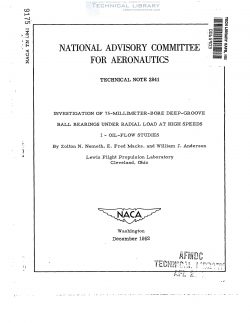naca-tn-2841
- Version
- 138 Downloads
- 1.09 MB File Size
- 1 File Count
- January 17, 2017 Create Date
- January 17, 2017 Last Updated
National Advisory Committee for Aeronautics, Technical Notes - Investigation of 75 Millimeter Bore Deep-Groove Ball Bearings Under Radial Load at High Speeds - I - Oil Flow Studies

Two 75-millimeter—bore (size 215) inner—race-riding cage—type ball
bearings were used in an experimental investigation of the effects of
load, oil flow, and oil inlet conditions on bearing operating character-
istics over a range6 of DN values (bearing bore in mm times shaft speed
in rpm) from 0. 5X106 to 1.2x106, static radial loads from 7 to 1115 pounds,
and oil flows from 2 to 8 pounds per minute; the absolute viscosity of
the oil at an inlet temperature of 100° F was 42.6xlO'7 rey'ns
(54.5 centistokes).
The radial location of the oil jet and the distribution of the oil
were found to be important factors in the lubricating and cooling effec-
tiveness of a given quantity of oil. Lowest average bearing temperatures
were obtained when the oil was directed at the space between the cage and
the inner race.
The quantity of the oil which flowed through the bearing had an
important effect on bearing operating temperatures and lubrication—
system.heat load. Outer-race temperature, which was found to be a
function of the quantity of oil transmitted through the bearing regard-
less of the lubrication method, decreased with increasing transmitted
oil flow. At a given total oil flow, the outer-race temperature was a
minimum when all the oil was made to flow through the bearing (achieved
by puddling). The inner-race temperature was dependent on the lubrication
method and was greater than the outer-race temperature when all the oil
flowed through the bearing. At constant total oil flow for single-Jet
lubrication, the power rejected to the oil increased with increasing
transmitted-oil flow and was maximum.when all the oil flowed through
the bearing.
Ball bearings operate under severe conditions in turbojet-
aircraft engines because of the high speeds, high loads, and high
temperatures encountered. very little information is available on
the performance characteristics and the limitations of high-speed
ball bearings or on how these characteristics and limitations are
affected by variables such as load, oil flow, and oil inlet condi-
tions.
| File | Action |
|---|---|
| naca-tn-2841 Investigation of 75 Millimeter Bore Deep-Groove Ball Bearings Under Radial Load at High Speeds - I - Oil Flow Studies.pdf | Download |

Comment On This Post